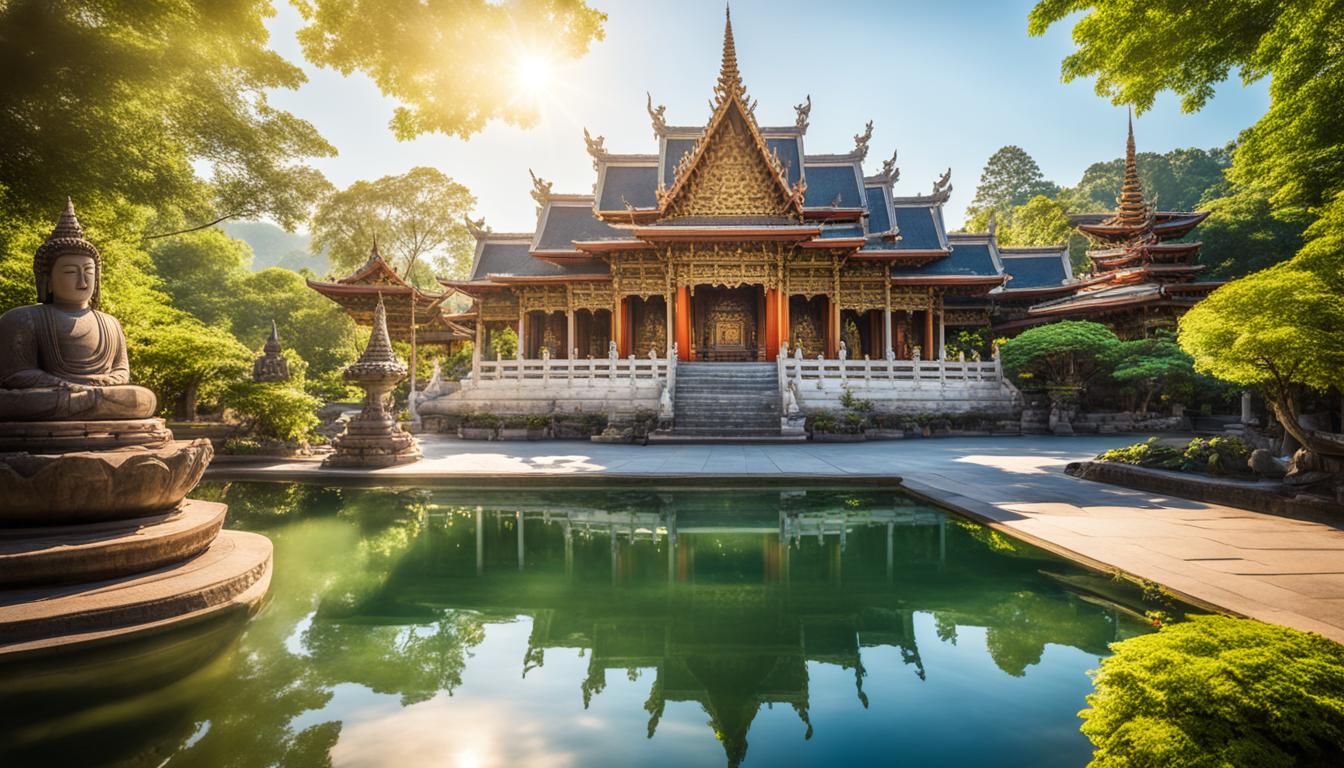Are you seeking a refuge from the chaos and noise of everyday life? A place where you can find tranquility and inner peace? Look no further than a serene Buddhist temple. Stepping into the hallowed grounds of a temple, you are transported to a realm of stillness and serenity.
The fragrance of incense dances in the air, and the gentle chants of the monks create a soothing symphony. Vibrant colors and statues of the Buddha adorn the temple, emanating peace and compassion in every corner. But beyond the aesthetics lies a profound wisdom, a path to discovering inner peace through mindfulness practice and dharma teachings.
In this article, we will explore the healing power of Buddhist temples, delve into the cultural heritage they embody, and uncover the transformative experiences that await those who embark on a spiritual journey within their sacred walls.
Key Takeaways:
- Buddhist temples offer a sanctuary of stillness, where inner peace can be discovered through mindfulness practice.
- The teachings of Buddhism provide valuable tools for cultivating tranquility and clarity in a fast-paced world.
- By immersing yourself in the healing ambiance of a Buddhist temple, you can find solace and reduce stress.
- These temples often serve as cultural havens, showcasing the rich heritage and traditions of communities.
- Visiting a Buddhist temple can be a transformative experience, allowing you to connect with your inner self and the world around you.
The Healing Power of Buddhist Temples
Buddhist temples have a profound healing power that extends beyond their physical walls. These sacred spaces provide an oasis of calm and serenity, offering solace and respite from the hustle and bustle of everyday life. The moment you step into a Buddhist temple, you are enveloped by a sense of peace and tranquility that allows you to leave behind your worries and enter a state of inner stillness.
At the heart of this healing power lies the practice of meditation. Buddhist temples often serve as meditation centers, where individuals can learn and deepen their mindfulness practice. Through the art of meditation, practitioners are able to quiet their minds, let go of stress and anxiety, and connect with their inner selves. The act of sitting in stillness and observing the breath brings about a profound sense of relaxation and clarity, helping individuals find their center amidst the chaos of the world.
Moreover, many Buddhist temples also offer spiritual retreats, providing an immersive experience for individuals seeking to deepen their connection to themselves and the teachings of Buddhism. These retreats allow participants to step away from their everyday routines and fully immerse themselves in a transformative spiritual journey. Guided by experienced teachers, retreat participants engage in various meditation practices, engage in contemplative discussions, and learn valuable techniques for personal growth and self-discovery.
One of the unique aspects of Buddhist temples is that they not only focus on individual healing but also promote a sense of community and collective well-being. Temples often host group meditation sessions, Dharma talks, and other communal activities, fostering a sense of unity and shared spiritual growth. These interactions provide opportunities for individuals to connect with like-minded seekers, share experiences, and support one another on their respective spiritual paths.

Ultimately, the healing power of Buddhist temples lies in their ability to offer a sanctuary for the mind, body, and soul. Whether through individual meditation, spiritual retreats, or community gatherings, these sacred spaces provide the necessary environment and guidance for individuals to cultivate mindfulness, find inner peace, and embark on a transformative journey of self-discovery.
The Healing Power of Buddhist Temples – Summary
| Benefits | Example |
|---|---|
| Inner peace and tranquility | Feeling a deep sense of calm and relaxation after a meditation session |
| Stress reduction | Experiencing a decrease in stress levels and a greater ability to cope with life’s challenges |
| Connection to self and others | Feeling a sense of unity and connectedness with fellow practitioners during community gatherings |
| Personal growth and self-discovery | Gaining insights into one’s own thoughts, emotions, and patterns of behavior through meditation and contemplation |
| Spiritual immersion | Engaging in a transformative spiritual journey through participation in a retreat |
| Support and guidance | Receiving mentorship and teachings from experienced teachers and spiritual guides |
A Glimpse of Cultural Heritage at Byodo-In Temple
The Byodo-In Temple in Hawaii offers a unique opportunity to immerse yourself in the rich cultural heritage of the Japanese community. As a smaller-scale replica of the renowned temple in Uji, Japan, this enchanting Buddhist temple serves as a testament to the significance of Japanese immigrants in Hawaii’s history.
Wandering through the temple grounds, you will be captivated by the exquisite architectural splendor that reflects Japan’s refined artistry. The intricate detailing and traditional construction methods showcase the craftsmanship and dedication of the Japanese artisans who built this temple. It is a true embodiment of beauty and serenity.

The Byodo-In Temple serves as a cultural haven, where traditional Japanese ceremonies seamlessly blend with local Hawaiian customs. It represents a harmonious fusion of two distinct cultures, symbolizing unity, peace, and cross-cultural understanding.
Visiting this temple allows you to gain a deeper appreciation for the vibrant tapestry of cultures and histories that have shaped Hawaii. It provides a glimpse into the past and pays homage to the enduring legacy of the Japanese immigrants who contributed to the diversity and richness of Hawaiian society.
Byodo-In Temple Highlights:
| Highlights | Description |
|---|---|
| Architectural Splendor | The temple’s intricate design and construction reflect Japan’s refined artistry, showcasing the beauty of traditional Japanese architecture. |
| Cultural Significance | Byodo-In Temple honors the first Japanese immigrants to Hawaii, portraying the cultural heritage and contributions of the Japanese community. |
| Cross-Cultural Blend | Witness the seamless blending of traditional Japanese ceremonies with local Hawaiian customs, symbolizing unity and peace. |
| Serene Atmosphere | Experience a sense of tranquility as you stroll through the temple grounds, surrounded by lush gardens and scenic beauty. |
Visiting the Byodo-In Temple in Hawaii is not only an opportunity to connect with Japanese culture but also a chance to embrace the profound sense of peace and harmony that Buddhism offers.
Finding Serenity at the Amitabha Stupa and Peace Park
Situated at the base of majestic Thunder Mountain in Sedona, the Amitabha Stupa and Peace Park offers a tranquil retreat for those seeking serenity and spiritual awakening. As you step into the park, you are immediately enveloped by the breathtaking beauty of the red rocks, the soothing presence of pinion pines, and the gentle rustling of junipers in the wind. The park resonates with tranquility, inviting you to leave behind the chaos of everyday life and immerse yourself in a peaceful sanctuary.

Every element of the Amitabha Stupa and Peace Park is carefully designed to inspire a sense of awe and calm. The melodious chimes that echo through the park and the vibrant Tibetan peace flags that flutter in the breeze create an atmosphere of harmony and serenity. As you wander along the winding paths, you can feel the whispers of ancient spiritual wisdom and the presence of something greater than yourself.
The centerpiece of the park is the Amitabha Stupa, a sacred Buddhist shrine that represents blessings and enlightenment for all beings. This magnificent structure serves as a focal point for meditation, allowing you to center your mind and connect with your inner self. The Stupa is adorned with intricate carvings and sacred symbols that carry deep spiritual significance, evoking a sense of reverence and awe.
Embarking on a Journey of Self-Discovery
Visitors flock to the Amitabha Stupa and Peace Park from all around the world to find solace, seek guidance, and experience spiritual awakening. It is a place where you can escape the noise and distractions of modern life, and delve into the depths of your own consciousness. The park offers a refuge for meditation, reflection, and self-discovery, allowing you to tap into a profound sense of peace and connectedness.
The serene environment and sacred energy of the Amitabha Stupa and Peace Park create the perfect setting for meditation and introspection. As you close your eyes and center your awareness, the distractions of daily life fade away, and you are able to find a deep sense of tranquility within. The practice of meditation in this sacred space can lead to profound insights, spiritual growth, and a renewed sense of purpose.
Seeking Guidance and Offering Prayers
The Amitabha Stupa and Peace Park also serve as a place of prayer and ritual. Visitors come here to seek guidance, offer prayers for healing, and express gratitude for blessings received. They bring flowers, stones, and personal trinkets as offerings, infusing them with their intentions and heartfelt prayers.
Within the Amitabha Stupa itself, millions of mantras and prayers for peace and compassion are housed. This sacred space holds the collective energy of all those who have visited, creating a profound source of empowerment and spiritual energy.
Whether you are on a personal spiritual journey, searching for inner peace, or seeking solace in a chaotic world, the Amitabha Stupa and Peace Park beckon you with its serene beauty and transformative energy. It is a place where you can connect with the divine within yourself, find clarity of mind, and experience a spiritual awakening that resonates long after you leave.
The Power of Intention at the Amitabha Stupa
The Amitabha Stupa, located in the serene Amitabha Stupa and Peace Park, holds a profound significance as an enlightenment shrine. This sacred Buddhist temple is a gateway to spiritual awakening and personal transformation.
As you enter the Amitabha Stupa, you will feel the powerful energy of intention and prayer that permeates the air. Visitors from all walks of life come here to offer their heartfelt prayers and intentions, seeking solace, healing, and guidance.

Inside the stupa, millions of mantras and prayers for peace and compassion resonate, uplifting the spirit and creating an atmosphere of tranquility and serenity. The stupa also houses sacred items and relics, adding to its spiritual significance.
The act of leaving offerings at the Amitabha Stupa holds deep meaning. Visitors leave flowers, stones, and personal trinkets as a symbolic gesture of devotion and gratitude. Written prayers are also left behind, carrying the hopes and wishes of individuals for themselves, their loved ones, and the world.
Experiencing the Amitabha Stupa’s ambiance and participating in the act of prayer and intention is a powerful way to connect with your own spirituality and embark on a journey of self-discovery. The stupa serves as a beacon of hope, radiating positive energy and fostering spiritual growth.
Reflection and Contemplation in Natural Beauty
Buddhist temples often embrace the natural beauty that surrounds them, creating a harmonious environment for reflection and contemplation. The Amitabha Stupa and Peace Park in Sedona offers visitors the opportunity to meditate and unwind amidst the striking red rocks and the peaceful melodies of nature.
Walking the meandering paths, lined with pinion pines and junipers, allows for a deep connection with the environment and an escape from the busyness of daily life.
The serene surroundings and sacredness of the land contribute to the overall sense of peace and healing.
Embracing Mindfulness and Compassion
Buddhist temples are dedicated to cultivating mindfulness and compassion. These core teachings of Buddhism guide individuals towards understanding suffering and its causes, leading to personal and societal harmony. By practicing mindfulness, individuals learn to be fully present in the moment and develop a deeper understanding of themselves and others. Cultivating compassion helps break down barriers and fosters a sense of interconnectedness and empathy. Through these practices, individuals can find inner peace and contribute to a more peaceful and compassionate world.
The Transformative Power of Mindfulness
Mindfulness is the practice of paying attention to the present moment with non-judgmental awareness. In a fast-paced world filled with distractions, mindfulness allows individuals to slow down, tune in, and experience life fully. By engaging in mindfulness meditation, individuals develop the ability to observe their thoughts and emotions without getting carried away by them. This practice cultivates a sense of clarity, calmness, and inner peace.
Mindfulness can be incorporated into daily activities, such as eating, walking, or simply breathing. By bringing a non-judgmental awareness to these moments, individuals can savor the richness of life and find joy in the simplest of experiences. Mindfulness also enhances self-awareness, allowing individuals to understand their patterns of thinking and behavior. This self-awareness is a foundation for personal growth and transformation.
The Path of Compassion
Compassion is at the heart of Buddhist teachings. It is the ability to recognize the suffering of oneself and others, and the desire to alleviate that suffering. Cultivating compassion involves developing empathy, kindness, and a genuine concern for the well-being of all beings.
Through the practice of loving-kindness meditation, individuals generate feelings of love, friendliness, and goodwill towards themselves and others. This practice helps break down the barriers of self-centeredness and promotes a sense of connection and interdependence. By extending compassion to oneself, individuals can heal their own wounds and develop a greater capacity to offer compassion to others.
The Ripple Effect of Mindfulness and Compassion
When individuals embrace mindfulness and compassion in their lives, the impact ripples outwards, touching the lives of those around them and creating a more interconnected and compassionate society.
Mindfulness and compassion empower individuals to respond to challenges with wisdom and kindness, rather than react with anger or judgment. This enables healthier and more harmonious relationships, fostering a sense of understanding and empathy in the world.
By embodying mindfulness and compassion, individuals become agents of positive change. They inspire others through their actions and words, creating a ripple effect of kindness, compassion, and inner peace.
| Benefits of Mindfulness and Compassion Practice | How it Enhances Well-being |
|---|---|
| Reduces stress and anxiety | By focusing on the present moment and cultivating compassion, individuals can reduce stress levels and find inner calm. |
| Improves mental clarity and focus | Mindfulness practice enhances concentration, allowing individuals to be more present and attentive in their daily activities. |
| Fosters emotional resilience | Mindfulness and compassion enable individuals to face challenges with equanimity and respond rather than react to difficult emotions. |
| Strengthens relationships | Mindfulness and compassion create a foundation for healthy and meaningful connections, promoting understanding and empathy in relationships. |
| Enhances self-compassion | Through mindfulness practice, individuals learn to treat themselves with kindness and compassion, leading to increased self-acceptance and well-being. |
Conclusion
Buddhist temples provide a sanctuary for those on a spiritual journey, seeking inner peace and personal growth. Stepping into these temples, you are enveloped in a serene environment that invites introspection and reflection. The teachings of Buddhism, combined with practices like meditation and mindfulness, offer invaluable tools for transforming your life and finding harmony within.
By embracing mindfulness and compassion, you embark on a transformative journey of self-discovery. Buddhist temples nurture these qualities, encouraging you to fully experience each present moment and cultivate empathy for yourself and others. Through your visits to these temples, you gain a deeper understanding of suffering and compassionately contribute to a more peaceful world.
A visit to a Buddhist temple is an invitation to explore your inner landscape and connect with the serenity that resides within you. It is a reminder that true peace is not found in external circumstances, but rather within your heart. So, when you find yourself longing for inner peace and a sense of purpose, remember that a Buddhist temple offers a sacred space for your spiritual journey and the keys to unlocking the peace that already resides within you.
FAQ
What is a Buddhist temple?
A Buddhist temple is a sacred place where individuals can engage in mindfulness practices, meditation, and receive dharma teachings. It serves as a haven of tranquility and spiritual growth.
What is the purpose of meditation in Buddhist temples?
Meditation is a core practice in Buddhism that helps quiet the mind, cultivate inner peace, and access a state of stillness and clarity. It is a tool for self-discovery and a means to develop mindfulness and compassion.
Can I visit a Buddhist temple even if I am not a Buddhist?
Yes, Buddhist temples are open to visitors of all backgrounds and beliefs. They provide a welcoming space for individuals seeking inner peace, spiritual growth, or simply a serene environment for reflection.
Do Buddhist temples offer guided meditation sessions?
Many Buddhist temples double as meditation centers and offer guidance and support for those seeking mindfulness practices. They often have experienced teachers who lead meditation sessions and provide instruction.
Do Buddhist temples organize spiritual retreats?
Yes, many Buddhist temples offer spiritual retreats where individuals can immerse themselves in the teachings and practices of Buddhism. These retreats provide an opportunity to deepen one’s connection to oneself and the world around them.
What is the significance of Byodo-In Temple in Hawaii?
Byodo-In Temple is a smaller-scale replica of a famous temple in Japan and was built to honor the arrival of the first Japanese immigrants to Hawaii. It symbolizes cross-cultural understanding and serves as a cultural haven, blending Japanese traditions with Hawaiian customs.
How does the Amitabha Stupa and Peace Park in Sedona offer serenity?
The Amitabha Stupa and Peace Park, nestled at the base of Thunder Mountain, provides a tranquil setting amidst the beautiful red rocks and nature’s melodies. It is a hidden gem for those seeking serenity and spiritual awakening.
What is the significance of leaving offerings at the Amitabha Stupa?
Visitors leave offerings of flowers, stones, and personal trinkets as symbols of their intentions and prayers. It is believed that these offerings hold spiritual significance and can bring guidance, healing, and positive energy.
How does nature contribute to the serenity of Buddhist temples?
Buddhist temples often embrace the natural beauty that surrounds them, creating a harmonious environment for reflection and contemplation. The serene surroundings, such as the red rocks in Sedona, contribute to the overall sense of peace and healing.
How do mindfulness and compassion play a role in Buddhist temples?
Buddhist temples are dedicated to cultivating mindfulness and compassion. These teachings guide individuals towards personal and societal harmony, helping them understand suffering, and develop empathy and interconnectedness with others.
Can visiting a Buddhist temple help me find inner peace?
Yes, visiting a Buddhist temple can be a transformative experience. By embracing mindfulness, compassion, and the power of intention, individuals can embark on a spiritual journey to discover peace within themselves and the world around them.

